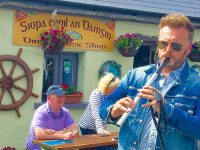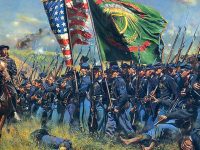Understanding Ireland’s ethnic British.
Note from Stephen:
“In my teaching about Ireland, nothing is more important to me than seeking harmony and an understanding of the ‘’other tribe’ that shares my beloved Island of Ireland. The 1 million strong tribe who have lived in Ireland for centuries and who’s members often decline to call themselves Irish. If you love travelling to Ireland, then I think you should learn about this important group and their unique form of Britishness.
In seeking to understand them, on rare occasion I have been ridiculed or criticised by some among my own tribe. I’m ok with that. I like the teachings of Jesus, I find his message cool. Thus i have no problem loving my enemy. To make peace, we must understand and offer friendship. I’m a proud Irish nationalist, proud of my Irish catholic traditions. I daydream of a United Ireland, but there are many who don’t. This section of my website teaches about them.
IMPORTANT FACT #1: On the Island that is called Ireland, almost 1 million people have a Protestant and/or British identity, carry a British passport and are content to be part of the UK.
IMPORTANT FACT #2: The overwhelming majority of Protestants in Ireland, particularly in the North, are NOT Irish Catholics who’s ancestors converted. They are descended from English and Scottish protestant settlers who came to Ireland in several waves, but primarily in the intensive ‘Plantation of Ulster’ in the early 1600’s.Their ancestors came from Britain, not Ireland, and that helps explain a big reason why they are still loyal and culturally affectionate to Britain today.
IMPORTANT FACT #3: I passionately believe that if you visit Ireland and do not make yourself aware of and at least try to understand the Protestant/British identity, then you are cannot fully say you understand the soul of this great nation.
IMPORTANT FACT #4: Northern Ireland is now and for the foreseeable future a constituent part of the United Kingdom.*
- It still surprises me the huge amount of visitors who are not aware of this political reality, I also regularly host visitors who think that all of Ireland is still part of the UK. One of my life’s missions is to educate a better understanding of the ‘Northern Ireland’ situation.
Ireland, my beautiful Island homeland, has for many people long been synonymous with religious quarrels and even violence between Protestant and Catholic.
In my 20 year career I have found this subject to be very interesting for visitors and it’s an issue they often ask questions about. It sparks a genuine curiosity and thirst for knowledge.
I’ve also found that many visitors haven’t the foggiest idea about the reality of what happened or is happening, particularly with regard to the issue of ‘Northern Ireland’ or as many like me prefer to call it – ‘The North’ . Their facts are often very wrong and their understanding of Ireland’s religious divisions very muddled and confused.
These misunderstandings are particularly evident when visitors enquire with me about the relationship between North and South. Even more so when I introduce them to the reality of the 800,000 or so people in the North/North-Eastern part of Ireland who carry British passports, have an affection for the Queen and the Royal family, and most of whom when asked their nationality, will respond ‘British’!
This post is about them, and my lifelong mission to understand them, respect them and come to terms with their ‘Britishness’ (a feeling or identity I do not share, nor have any desire to). And most importantly – to be sure to live in peace and harmony with them. They are my neighbours after all.
The history of ‘the Protestants’ in Ireland
Ireland has a unique story in Europe when it comes to religion and the reformation.
The vast majority of the Catholic people of Ireland did not convert. Instead what happened was an army from a Protestant Island invaded a neighbouring Catholic Island and conquered it, and then brought it its own Protestant citizens to live there in the Catholic Island (mostly in the North), these Protestant settlers and their descendants remained loyal to the Protestant Island and its monarchy, system of government and its culture to the present day.
Stephens note: the above paragraph is seriously simplifying things but it is also historical fact. In my teaching I try to shed light on the historical reasons why a large chunk of Ireland’s population identifies as proudly British. I once attended a lecture by loyalist politician David Irvine at my Alma Mater, Queens University in Belfast, and he reminded us eager young Irish Nationalists present (the University’s student body and particularly the students union is heavily dominated by the Irish Nationalist/Catholic community) that he was not going to wake up one day and feel Irish, he was never going to realise his love of being British was all just a dream or figment of his imagination. “it’s not gonna happen lads” he told us in his heavy East-Belfast accent. At that moment, for the first time in my life, I agreed with that sentiment, still do.
England conquered Ireland with its armies, confiscated the lands and farms from Catholics, and afterwards introduced a colonial Protestant population from England and lowland Scotland and granted the lands to them. This was particularly evident in the Northern province of Ulster.
As most other Northern European lands protested against the Pope and switched to various forms of Protestant Christianity, people in Ireland remained loyal and faithful to the Vatican.
By the time Martin Luther and others began the Protestant reformation, much of Ireland was already under de-facto rule by the English King Henry VII. Though most of the North (Ulster) in particular was fiercely independent and ruled with an iron fist by powerful Gaelic clans and warlords like the O’Donnells and the O’Neills.
Large Anglo-Norman Clans (sometimes referred to as Hiberno-Norman) such as the Fitzgeralds in Bunratty Castle or the Butlers in Kilkenny Castle, would collect taxes locally and present a share to the English King. They would offer him loyalty and apply his laws in Ireland, as long as he left them alone to be the masters of their regions, if the English King didnt, then they’d rebel (which they occasionally did on grand scale and which invariably ended in their destruction)
Countries like England, Scotland, Wales, the Scandanavian countries, the Dutch Republic and Northern Germany experienced most of its people become Protestant. But Ireland remained religiously linked to Southern Europe, to countries like Italy, France, Spain and Portugal. Some of these Catholic countries would soon send military help to their beleaguered Catholic celtic-cousin when the violent conquest began from newly Protestant England. By 1601, little Ireland was the remaining Catholic outpost in North-Western Europe, alone in a sea of Protestant fervour.
In 1601, at the battle of Kinsale in the very south of Ireland, a town that every visitor to Ireland should try and stay in for at least one night, the Gaelic Chieftain of the North (Ulster) and their fellow-Catholic allies, the Spanish, were defeated by the English Army of Queen Elizabeth I. This left a power-vacuum up North and eventually enabled the English to mop up any resistance and conquer some years later after an event generally called ‘The Flight of the Earls’, where the remaining Ulster Chieftains sailed away for refuge and to seek help in Spain from the small town of Rathmullen in County Donegal (the town has a decent museum on the event and a fine beach, but not a whole lot else going on these days in terms of reasons to visit, I say this with certain expertise as I spent every summer Sunday there with my parents and siblings for 5 years. I returned in the summer of 2016 with my own family to stay in the pleasant and sedate Rathmullan House, and the town was a shadow of its former self).
Protestants in Northern Ireland today
The Protestant community in Northern Ireland today is actually quite disparate in terms of religious belief and practice. There is everything from liberal Church of ireland (part of the world-wide Anglican Communion and the Ireland version of the Church of England or the Episcopal Church in the US to fundamentalist evangelical denominations, and everything in between and beyond. There are Moravians in Armagh (a group of protestants from what is now the Czech Republic who sought sanctuary in Ulster in the 17th century), Plymouth Brethern, a recent First Minister of the Northern Ireland Assembly – Peter Robinson, is Elim Pentecostal; there are Baptists, Methodists and several different types of Presbyterian! In my class at University we had a 2 regular Presbyterians, 1 reformed Presbyterian, 1 evangelical Presbyterian, and one guy who claimed he was a ‘Catholic-Presbyterian’, that one really baffled us – he kindly informed me it was a Church that stood for Universal Presbyterians, Catholic being the Latin word for universal. We had one ‘Presbyterian’ atheist, who identified as Protestant if asked in the pub (or on a job-application form, yes its the law) but hadn’t been to Church in 10 years, nor had any intention of ever doing so again. And last but not least we had a bunch of Free Presbyterians, the ‘Wee Frees’, a small but influential Church in Northern Ireland founded by the famous and fiery preacher, the Dr. Rev. Ian Paisley RIP.*
* Ian Paisley – a friend of American televangelist Billy Graham, First-Minister of the Northern Ireland Assembly and who got his Doctorate from Bob Jones University in South Carolina! The Rev. Paisley was quite a divisive character, once ejected from the European Parliament for calling Pope John Paul “the anti-christ” and ripping in two the Catholic Eucharist while waffling on about ‘worshipping a wafer god’. I recall this causing great hurt among many of the older and more pious in the congregation in my local Catholic Church. Though of course many Catholics simply rolled their eyes and laughed it off.
Ian Paisley went on to become an even more remarkable figure in his later years, sharing government with his former arch-enemies – Sinn Fein (the political party who are proud of their links to the IRA for example). He would talk eloquently (his oratory skills were the stuff of legend) about the need for our Grand-children’s generation to share this beautiful and and work in peace and harmony.
And this is a key point in my teaching that I repeat ad-nauseam until it gets through to those visitors interested in learning about Ireland. the vast majority of Protestants in Ireland wish to and do live in peace and harmony with there Catholic neighbours.
Despite all the denominational differences, the Protestant community in the North is collectively described as the ‘Unionist Community’ in political terms, (and often ‘Loyalist community’ although this term is generally used to refer to unionists who are more militant, extreme and even prepared to use violence to further their political cause), and this is where is more cohesion. As the majority of Protestants in the North vote for Unionist political parties, which means they wish to maintain the Union. the Union of Northern Ireland and Britain (which used to be the Union of all of Ireland and Britain until 1922). Remember, the front of every British passport in the world states – The United Kingdom of Great Britain & Northern Ireland.
Occasionally a celebrity, sports-star or high-profile business-person from the Unionist community will express their desire for a United Ireland, but it is very rare.
There are of course some people from a Protestant/Unionist background who don’t identify as British, but prefer to be Irish, or quite a few who identify as both Irish and British – just as a Scottish, English or Welsh person might well say they are also British. I have many friends and acquaintances in all these categories.
Identity is a fascinating and complex subject in Ireland. It can be divisive and cause problems, even deaths. But it also has the ability to enrich us and gives us inhabitants Ireland a great sense of depth in both heritage and history.
Some high-profile celebrities from a Protestant/Unionist background are Kenneth Branagh (Professor Lockhart in Harry Potter among other acting roles), the legendary Van Morrison, Ferrari Formula 1 driver Eddie Irivine.
Protestants in the Republic of Ireland today
After Independence from Britain, the new Irish Free State saw its Protestant population dwindle from around 10% to 2%. Many sold up and went/fled North for fear of attack and reprisals from Catholics or the IRA. This feeling of fear was real and sadly many Protestant farmers and landowners were killed. Others perhaps left as they prefer to live in an area under British Jurisdiction. Protestant fears of a new independent state dominated by the Catholic Church were proved right in my opinion and others, by the 1930’s and the writing of the Irish Constitution, the teachings of the Catholic Church were often enforced in the laws of the Irish Free State (later to become the Republic of Ireland.
I grew up in East Donegal, where the Protestant population was unusually high (around 20% of the population perhaps) and I counted these people among my neighbours. Although we went to separate schools and of course Churches, played different sports (they Rugby, hockey and badminton, whilst my lot played Gaelic Football and a little hurling) and even went to different boy-scout troupes – there was no violence or animosity, and all lived amicably side by side for the most part.
The vast majority of Protestant people in the Republic of Ireland today have a proud allegiance to the state they live in and participate in it fully. They have fulfilled roles from President of the Gaelic Athletic Association (GAA) to the role of President of the Republic of Ireland. Some may identify as British, though I have never heard that sentiment expressed, but first and foremost they are Irish. Citizens of a modern Irish society, aware and proud of their protestant heritage and identity.
Notable celebrities from a protestant background in the Republic of Ireland include one of the most high-profile TV chat show hosts in the UK, Graham Norton.
The Scots-Irish
I often recall this brief conversation with a tour-guest that sums up the misunderstandings and mystery that people sometimes have about this often-mentioned group, the Scots-Irish.
Tourist: I’m Scots-Irish. My Grand-daddy was Irish, My Grandma was Scottish.
Me: Actually no, that means you’re Scottish and you’re Irish. The Scots-Irish were a distinct ethnic group, from the lowlands of Scotland, generally always Presbyterian, who came to the North of Ireland in huge numbers around 1608-1620, settled and farmed on land confiscated from native Irish Catholics, and then moved on in equally huge numbers to the Appalachian states of the US, peaking in the 1720’s and giving America a community who counted 17 Presidents among its descendants.
A bit of a mouthful, but an important one to let forth now and then.
The Irish in the British Army. Then and now.
History demonstrates that vast numbers of Irishmen, possibly millions, both Catholic and Protestant, have served in the uniform of the British Army, from the Battle of Waterloo against the French to the Battle of the Somme agains the Germans.
Since Independence in 1922, this tradition has dwindled among men from the Catholic/Nationalist community in Northern Ireland and among all sections of the Republic of Ireland in general.
With the exception of World War 2, when almost 60,000 men with addressed in the Republic of Ireland joined the British Army to fight Nazi Germany and its allies.
In Northern Ireland, my paternal Grandfather, John McPhilemy, joined the Royal Inniskilling fusiliers and would eventually find himself fighting hand-to-hand on the beaches of Normandy on D-Day.
After World War 2, recruitment to the British Army continued to be high in Northern Ireland, but with the onset of ‘the Troubles’ in the North, recruitment to the British Army from Catholic/Nationalist /Irish areas of the North plummeted, especially after the dark tragedy of Bloody Sunday (1972) in Derry, when 14 innocent civilians were killed by the British Army during a civil-rights march.
As a result the British Army became synonymous with with one community, the protestant/Unionist/British community, and today there is still a large military culture and tradition of recruitment there. It is not uncommon for my American/Canadian guests and I to be sipping a pint in a downtown Belfast with a man or woman who has served in Afghanistan or Iraq alongside their own family members. One of the largest regiments in the British Army is the Royal Irish Regiment, who’s members are mostly from a loyalist background but project a very strong Irish image with their use of the Irish Wolfhound and traditional dress when presented by shamrocks by the Duchess of Cambridge each St. Patricks Day at Buckingham Palace.
In recent years, with temporary recruitment bans to the Defence Forces of the Republic of Ireland due to the economic crisis, the removal of a taboo due to the peace-process in Northern Ireland and the desire for adventure among some young men and women, there has been an increase in recruitment to the British Army from citizens resident in the Republic of Ireland. This interesting situation often is highlighted in the media when one of their number would be tragically killed-in-action in the recent conflicts in Iraq and Afghanistan.
The Orange Order and the Orangemen
During my years travelling Ireland with Americans, I would always have to begin any teaching about the Orangemen by reminding those present that I was not referring to the University of Syracuse basketball team!
Most travellers have never heard of the Orangemen except for those who watch the news and would occasionally see violence flare up after Orange marches would march by or close to Catholic neighbourhoods in the North of Ireland.
The Orange Order are a fraternal oath-bound group for Protestant males (though there is also a separate female version). Some call it a secret society, they themselves have told me they are a “society with secrets”!
The organisation is quite influential in Northern Ireland and has in the region of 80,000-100,000 members. Orangmen celebrate the Battle of the Boyne which took place in 1690 between King William of Orange (affectionately known as good King Billy by the protestant community, and is even suggested as a reason why the term ‘hillbilly’ was coined in the appalachians, due to so many Scots-Irish protestant emigrants being called Billy!) and his Uncle King James the 2nd, who was also his Father-in-law! Confused? It’s ok, read on.
There are around 3000 Orange marches annually from Easter Monday until the first Sunday in September. The biggest orange march is on July 12th, the date used to celebrate the Battle of the Boyne (although the Battle actually happened on July 1st, but the modern calendar is 11 days different to the Calendar we used then). In fairness it is quite the spectacle. But is nothing like the pageantry and festivity associated with St. Patricks Day, not a bias just a fact. The two do share the same amount of drunkeness on the fringes however (again speaking from eyewitness experience).
Would I recommend visitors attend Orange marches? Absolutely – Yes!
I find the spectacle fascinating, and I have brought many visitors to see Orange Marches, when other tour-guides and tour-companies were cancelling tours and re-routing (no pun intended. Only Irish readers will get this reference) out of town.
Click here to read the experience of US travel TV star, Rick Steves at an Orange March in Portrush, which made it on to his programme on PBS. I was satisfied my local knowledge found an Orange march during our days of filming and that the Orange marching culture was presented to millions of Americans. What they made/make of it is up to them.
Stories to come:
Andy Steves in Belfast, 12th July
Burning Lundy
Dan Winters Cottage and tea with Hilda Winters
Rick Steves in his orange sash
With the riot-police (& Aussie backpackers) at anti-Orange protestors





